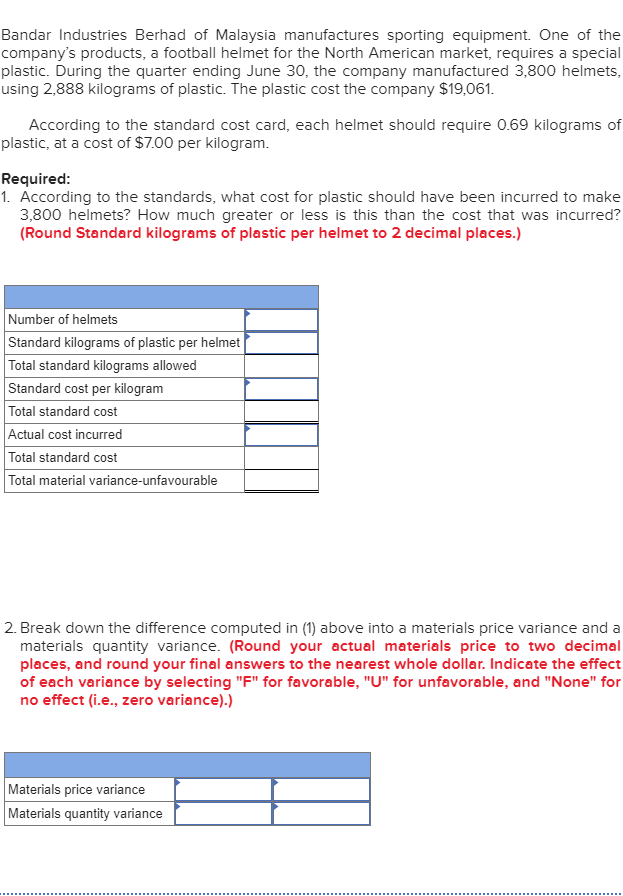Bandar Industries Berhad of Malaysia manufactures sporting equipment. One of the company's products, a football helmet for the North American market, requires a special plastic. During the quarter ending June 30, the company manufactured 3,800 helmets, using 2,888 kilograms of plastic. The plastic cost the company $19,061. According to the standard cost card, each helmet should require 0.69 kilograms of plastic, at a cost of $7.00 per kilogram. Required: 1. According to the standards, what cost for plastic should have been incurred to make 3,800 helmets? How much greater or less is this than the cost that was incurred? (Round Standard kilograms of plastic per helmet to 2 decimal places.) Number of helmets Standard kilograms of plastic per helmet Total standard kilograms allowed Standard cost per kilogram Total standard cost Actual cost incurred Total standard cost Total material variance-unfavourable 2. Break down the difference computed in (1) above into a materials price variance and a materials quantity variance. (Round your actual materials price to two decimal places, and round your final answers to the nearest whole dollar. Indicate the effect of each variance by selecting "F" for favorable, "U" for unfavorable, and "None" for no effect (i.e., zero variance).) Materials price variance Materials quantity variance
Bandar Industries Berhad of Malaysia manufactures sporting equipment. One of the company's products, a football helmet for the North American market, requires a special plastic. During the quarter ending June 30, the company manufactured 3,800 helmets, using 2,888 kilograms of plastic. The plastic cost the company $19,061. According to the standard cost card, each helmet should require 0.69 kilograms of plastic, at a cost of $7.00 per kilogram. Required: 1. According to the standards, what cost for plastic should have been incurred to make 3,800 helmets? How much greater or less is this than the cost that was incurred? (Round Standard kilograms of plastic per helmet to 2 decimal places.) Number of helmets Standard kilograms of plastic per helmet Total standard kilograms allowed Standard cost per kilogram Total standard cost Actual cost incurred Total standard cost Total material variance-unfavourable 2. Break down the difference computed in (1) above into a materials price variance and a materials quantity variance. (Round your actual materials price to two decimal places, and round your final answers to the nearest whole dollar. Indicate the effect of each variance by selecting "F" for favorable, "U" for unfavorable, and "None" for no effect (i.e., zero variance).) Materials price variance Materials quantity variance
Managerial Accounting
15th Edition
ISBN:9781337912020
Author:Carl Warren, Ph.d. Cma William B. Tayler
Publisher:Carl Warren, Ph.d. Cma William B. Tayler
Chapter11: Differential Analysis And Product Pricing
Section: Chapter Questions
Problem 2CMA
Related questions
Question

Transcribed Image Text:Bandar Industries Berhad of Malaysia manufactures sporting equipment. One of the
company's products, a football helmet for the North American market, requires a special
plastic. During the quarter ending June 30, the company manufactured 3,800 helmets,
using 2,888 kilograms of plastic. The plastic cost the company $19,061.
According to the standard cost card, each helmet should require 0.69 kilograms of
plastic, at a cost of $7.00 per kilogram.
Required:
1. According to the standards, what cost for plastic should have been incurred to make
3,800 helmets? How much greater or less is this than the cost that was incurred?
(Round Standard kilograms of plastic per helmet to 2 decimal places.)
Number of helmets
Standard kilograms of plastic per helmet
Total standard kilograms allowed
Standard cost per kilogram
Total standard cost
Actual cost incurred
Total standard cost
Total material variance-unfavourable
2. Break down the difference computed in (1) above into a materials price variance and a
materials quantity variance. (Round your actual materials price to two decimal
places, and round your final answers to the nearest whole dollar. Indicate the effect
of each variance by selecting "F" for favorable, "U" for unfavorable, and "None" for
no effect (i.e., zero variance).)
Materials price variance
Materials quantity variance
Expert Solution
This question has been solved!
Explore an expertly crafted, step-by-step solution for a thorough understanding of key concepts.
This is a popular solution!
Trending now
This is a popular solution!
Step by step
Solved in 2 steps with 1 images

Recommended textbooks for you

Managerial Accounting
Accounting
ISBN:
9781337912020
Author:
Carl Warren, Ph.d. Cma William B. Tayler
Publisher:
South-Western College Pub

Managerial Accounting
Accounting
ISBN:
9781337912020
Author:
Carl Warren, Ph.d. Cma William B. Tayler
Publisher:
South-Western College Pub